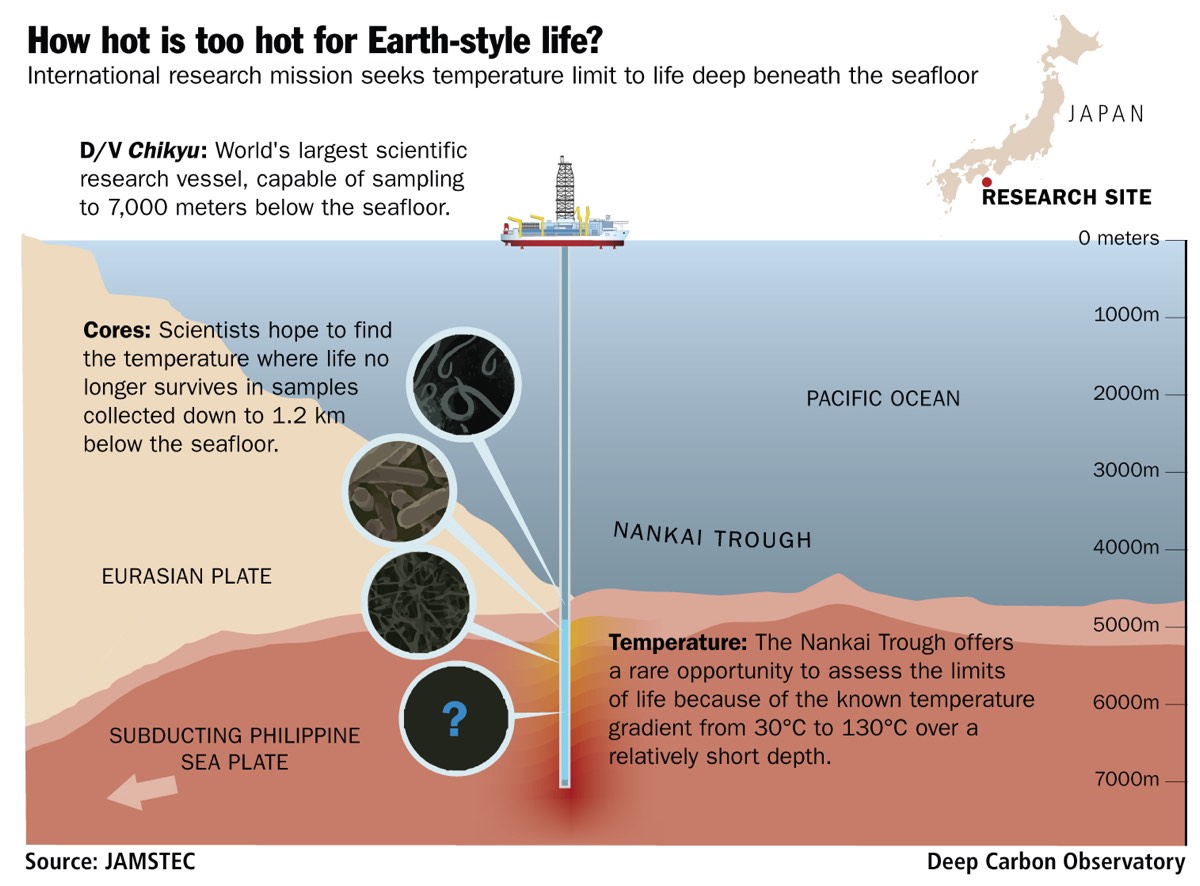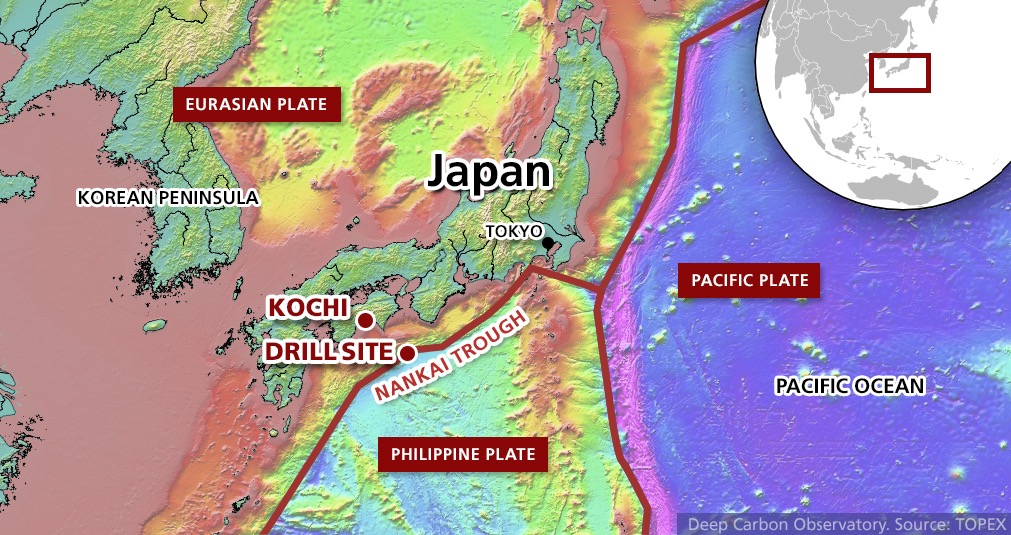The Heat Is On: Search Begins for 'Alien' Life Beneath Earth

By exploring the limits of life deep beneath the seafloor, an upcoming international research mission will seek to discover what scorching levels of heat may be too extreme for life on Earth — and maybe alien life on distant worlds.
The public can also take part in an online contest to guess the hottest temperature at which life can exist.
On Sept. 12, scientists are heading out for a 60-day quest aboard the state-of-the-art Japanese drilling vessel Chikyu to the Nankai Trough, about 75 miles (120 kilometers) off the coast of Japan. The ocean is about 2.9 miles (4.7 km) deep there, and the expedition will drill down 0.75 miles (1.2 km) beneath the seafloor to collect samples. All in all, the distance from the ocean's surface to the sample depth is equivalent to the height of about 20 Eiffel Towers. [Infographic: Explore Earth from the Tallest Mountain to the Deepest Ocean Trench]
New life-forms?
The Nankai Trough is located near the superhot border of two clashing tectonic plates, where underwater volcanoes bubble like cauldrons. The samples that researchers will collect may reach temperatures of 266 degrees Fahrenheit (130 degrees Celsius). Gathering such hot samples in other areas would require drilling to about 2.5 miles (4 km) below the seafloor, rather than the 0.75 miles currently planned, the researchers said.
"We may discover some unknown life-forms that can survive or adapt to the extremely challenging deep and hot sedimentary environment," Fumio Inagaki, the expedition's co-chief scientist and a researcher at the Japan Agency for Marine-Earth Science and Technology, told Live Science. "The nature and extent of the deep sub-seafloor biosphere is still largely unknown."

Analyzing such deep-sea microbes could help scientists inthe search for alien life. "We have already known, based on previous DNA-based studies, that most microbes living in marine subsurface sediments are evolutionarily distinct from known life in the Earth's surface biosphere," Inagaki said. "In this sense, we may have already seen alien life in the different world on our planet," since they are distinct from life on the surface, he noted.
"Our study will provide some clues to understand habitability of deep life not only below the ocean floor of our planet, but also inside of other celestial bodies," Inagaki added. A deeper understanding of how life might live in extreme places on Earth could shed light on whether or not it could exist in similarly extreme places elsewhere.
Sign up for the Live Science daily newsletter now
Get the world’s most fascinating discoveries delivered straight to your inbox.
A globular, single-celled organism called Geogemma barossii tolerates the highest temperatures of any catalogued life-form on Earth. The microbe was discovered in 2003, in deep-sea hydrothermal vents at the Juan de Fuca Ridge off the northwest U.S. coast, where it withstands temperatures of about 250 degrees F (120 degrees C). The new samples that scientists hope to collect as part of the International Ocean Discovery Program's (IODP) Expedition 370 may yield microbes that break the current record for the hottest temperature at which life on Earth can exist. [Axial Seamount: Images of an Erupting Undersea Volcano]
Like a trip to outer space
Chikyu is the world's largest scientific research ship, measuring 689 feet long, 125 feet wide and 393 feet high (210 by 38 by 120 m), Inagaki said. A system of thrusters and GPS sensors also makes the ship quite stable, "enabling the vessel to keep at the same position for deep drilling under strong currents," he added.

Indeed, an ordinary research vessel wouldn't suffice for such an extreme mission.
"This expedition is as complex as a mission to outer space might be," Kai-Uwe Hinrichs, a researcher at the University of Bremen in Germany and lead author of the scientific proposal behind the expedition, said in a statement.
"It requires the technology to 'land' the coring bit on the right spot in over 4-kilometer-deep water, drill through ancient ocean sediments to collect samples far below the ocean floor, bring them back onboard intact, then transport them by helicopter to the super-clean geomicrobiology laboratory to ensure no contamination," Hinrichs added. "Like a space mission, this expedition is fraught with complexity, danger and vast opportunity for discovery."
After the samples are collected, they will be sent on a 1-hour helicopter ride to a superclean lab onshore (to prevent contamination), where scientists will investigate them further. The researchers will analyze the qualities of the sediments and count minuscule and sparse cells, looking for as few as 100 cells per 0.06 cubic inches (1 cubic centimeter), or about the equivalent of 100 sand grains floating in an Olympic-size swimming pool.
"Looking for life in core samples is like looking for a needle in a haystack," Yuki Morono, the expedition's co-chief scientist and a researcher at the Kochi Institute for Core Sample Research in Japan, said in the statement. "At the surface, the sediments are teeming with microbial cells, but in samples from deeper in the core, the cells become far more sparse."
The aim of the expedition is to define the limits to deep-dwelling life by exploring the so-called biotic fringe, the boundary where current knowledge predicts that no living cells persist. The mission will examine whether this boundary is sharp, diffuse or exists at all.
"We have the extraordinary opportunity to explore the depth at which sediments and rocks become too hot for life, even for microbes that can live at temperatures greater than 85 degrees C [185 degrees F]," Verena Heuer, the expedition's co-chief scientist and a researcher at the University of Bremen in Germany, said in the statement.
"The gradual increase in temperature from approximately 30 degrees C to 130 degrees C [86 to 266 degrees F] in the sampled sediments will give us the opportunity to explore how microbial life changes with increasing temperatures and ultimately ceases to exist," Heuer added. "Is this lower boundary of the sub-seafloor's habitable zone like a rigid brick wall, or is it like a leaky fence?"
The researchers will also use DNA-sequencing technology to determine the ancestry of deep-sea microbes and how they adapt to such extreme environments. During the cruise, they will share their experiences via blogs and the Expedition 370 website.
The public is also invited to guess the heat limit of deep life via an online contest.
Original article on Live Science.











